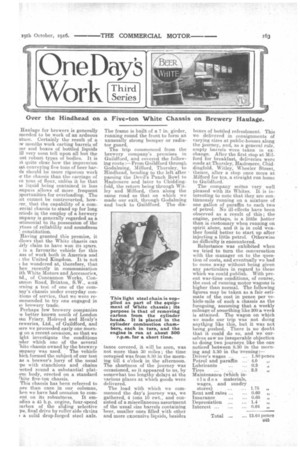Over the Hindhead on a Five-ton White Chassis on Brewery Haulage.
Page 13

If you've noticed an error in this article please click here to report it so we can fix it.
Haulage for brewers is generally >needed to be work of an arduous lture. Certainly the result of a ret months work carting barrels of ..er and boxes of bottled liquids ill very soon tell upon all but the ost robust types of bodies. It is 3t quite clear how the impression tat conveying five tons of beer bar31s should be more rigorous work ir the chassis than the carriage of ye tons of flour, unless it be that Le liquid being contained in less rmpass allows of more . frequent port unities for overloading. The 6ct cannot be controverted, howTer, that the capability of a comercial chassis to stand up for long eriods in the employ of a brewery impany. is generally regarded as a Istnnornal to its possession of the rtues of reliability and soundness ! constitution.
Having granted this premise, it Mows that the White chassis can irly claim to have won its spurs. ; is a favourite vehicle for this ass of work both in America and the United Kingdom. It is not be wondered at, therefore, that hen recently in communication ith White Motors and Accessories, td., of Concannon Works, Con',mon Road, Brixton, S.W., 001-4 3rning a test Of one of the cornany's chassis under everyday conttions of service, that we were reonmended to try one engaged in in brewery trade.
Perhaps few brewery companies .e better known south of London ion Friary. Holroyd and Healy's reweries, Ltd., of Guildford, and !ere we proceeded early one morn15 on a recent occasion, so that we ight investigate the conditions [icier which one of the several lute chassis owned by the brewery nripany was used. The vehicle hich formed the subject of our test as a brewer's lorry of the usual pe with stanchions and chains Toted round a substantial platprni body, erected on a standard rhite five-ton chassis.
This chassis has been referred to ore than once in our columns, hen we have had occasion to cem
ent. on its robustness. It emdies a 45 lep. engine, four-speed mrbox of the sliding selective pa, final drive by roller side chains a solid drop-forged steel axle.
The frame is built of a 7 in. girder, running round the front to form an unusually strong bumper or radiator guard.
The trip conrme-nced from the brewery company's, premises in Guildford, and covered the following route :—From Guildford through Godalming, Milford, Thu rsley, • to Hindhead, bending to the left after passing the Devil's Punch Bowl to Haslentere and later to Chiddingfold, the return being through Witley and Milford, then along the same road as that on which we made our exit, through Godalrning and back to Guildford. The dis tance covered, it will be seen, was not more than 30 miles ; the time occupied was from 8.30 in the morning till 4 o'clock in the afternoon. The shortness of the journey was occasioned, so it appeared to us, by somewhat too lengthy delays at the various places at which goods were delivered.
The load with which we commenced the day's journey was, we gathered, 4 tons 10 cwt., and consisted of a miscellaneous assortment of the usual size barrels containing 'beer, smaller ones filled with other and more expensive liquids, besides boxes of bottled refreshment. This we delivered in consignments of varying sizes at public-houses along the journey, and, as a general rule, empty barrels were taken in exchange. After the first stop at Milford for breakfast, deliveries were made at Thu rsley, Haslemere, Chiddingfold, Witley, Wheeler Street, thence, after a stop once more at Milford for tea, a straight run home to Guildford.
The company seems very well pleased with its Whites. It is interesting to note that they are continuously running on a mixture of one gallon of paraffin to each two of petrol. No ill-effects have been observed as a result of this ; the engine, perhaps, is a little hotter than is customary when running on spirit alone, and it is in cold weather fourid better to start up after injecting a little petrol. Otherwise no difficulty is encountered.
Reluctance was exhibited when we tried to turn the conversation with the manager on to the question of costs, and eventually we had to come away without being given any particulars in regard to these which we could publish. With preent war-time conditions, of course, the cost of running motor wagons is higher than normal. The followins figures may be taken as a fair estimate of the cost in pence per vehicle-mile of such a chassis as the foregoing, assuming that a weekly mileage of something like 300 a, week is attained. The wagon on which we made our trip was not doing anything like this, but it was not being pushed. There is no doubt that it could do so, and we ourselves saw no insuperable objection to doing two journeys like the one noticed between 8.30 in the morning and 5.30 in the -evening:—
Driver's wages ... ... 1.80 pence Petrol and paraffin ... 4.0






















